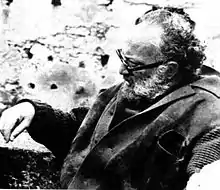Mario Landi
Mario Landi (October 12, 1920 – March 18, 1992) was an Italian director known for his giallo movies such as Giallo a Venezia and his television series Le inchieste del commissario Maigret.[1]
Mario Landi | |
|---|---|
 | |
| Born | October 12, 1920 Messina, Sicily, Italy |
| Died | March 18, 1992 (aged 71) Rome, Lazio, Italy |
| Nationality | Italian |
| Occupation | Director |
| Known for | Le inchieste del commissario Maigret |
Life and career
Born in Messina, Sicily, Landi attended the National Academy of Dramatic Arts in Rome, graduating in direction in 1944.[2] He began his career in theater, working with the best actors of his time, in particular being one of the most active protagonists of the "Diogene" cultural circle in Milan, a reference point for the Italian theater in the 1950s.[2] He made his debut as a film director in 1950, with the musical film Canzoni per le strade, but soon his interests shifted to the new medium of his era, the television;[2] he is regarded as a pioneer of Italian television, for which he worked since 1952, when RAI started experimental broadcasting before starting the regular TV service.[2][3] From 1955 to 1979 he directed a very large number of television movies and series, occasionally directing a few variety shows, including an edition of Canzonissima.[2][3] He was less active in cinema, in which he sporadically directed a number of low-profile genre films.[2]
Reception
The films of Mario Landi were not well received. Paolo Mereghetti, author of Il Mereghetti, wrote of Maigret a Pigalle: "the direction is slovenly",[4] while of Giallo a Venezia he wrote that it:[5]
"deserves (or perhaps does not deserve) to be remembered as one of the most idiotic Italian thrillers ever made, a collage of soft-porn sequences and dismemberments of rare brutality that fall into the void, in a childish attempt to astonish."
Filmography
As actor
- Howlers in the Dock (1960, as Il regista Lando)
- Cry of a Prostitute (1974, as Don Turi Scannapieco)
As director
- Canzoni per le strade (1950)
- Siamo tutti Milanesi (1953)
- Così è (se vi pare) (1954)
- Andrea Chénier (1955)
- Cime tempestose (1956, TV Mini-Series)
- All'insegna delle sorelle Kadar (1957)
- Canzonissima (1958, TV series)
- Canne al vento (1958)
- Il povero fornaretto di Venezia (1959)
- Il romanzo di un maestro (1959, TV Mini-Series)
- Lo schiavo impazzito (1960)
- Ragazza mia (1960, TV Mini-Series)
- Racconti dell'Italia di ieri - Un episodio dell'anno della fame (1961)
- Il piacere dell'onestà (1961)
- Racconti dell'Italia di oggi - Una lapide in Via Mazzini (1962)
- Ritorna il tenente Sheridan (1963, TV series, 6 episodes)
- Giacobbe ed Esau (1963)
- Le inchieste del commissario Maigret (1964-1972, TV series, 16 episodes)
- Maigret a Pigalle (1967)[6]
- Questi nostri figli (1967, TV Mini-Series, 4 episodes)
- Dossier Mata Hari (1967, TV Mini-Series, 4 episodes)
- I racconti del maresciallo (1968, TV series, 6 episodes)
- Dal tuo al mio (1969)
- Un mese in campagna (1970)
- Nessuno deve sapere (1972, TV Mini-Series, 4 episodes)
- Serata al gatto nero (1973, TV Mini-Series, 2 episodes)
- Batton Story (1976)
- L'altro Simenon (1979, TV Series)
- Accadde ad Ankara (1979, TV Mini-Series)
- La vedova e il piedipiatti (1979, TV Mini-Series, 6 episodes)
- Supersexymarket (1979)
- Giallo a Venezia (1979)[6][7][8]
- Il viziaccio (1980)
- Patrick Still Lives (1980)[6]
As Screenwriter
- The Two Sergeants (1951)
References
- Louis, Paul (2004). Italian Horror Film Directors. McFarland & Company. p. 1979. ISBN 0786418346.
- Roberto Poppi. I registi: dal 1930 ai giorni nostri. Gremese Editore, 2002. ISBN 8884401712.
- Aldo Grasso, Massimo Scaglioni. Enciclopedia della Televisione. Garzanti, 1996 – 2003. ISBN 881150466X.
- Mereghetti, Paolo (2003). Il Mereghetti: Dizionario dei Film 2004. Le schede. Milano: Baldini Castoldi Dalai. p. 1357. ISBN 88-8490-419-6.
la regia è sciatta.
- Mereghetti, Paolo (2003). Il Mereghetti: Dizionario dei Film 2004. Le schede. Milano: Baldini Castoldi Dalai. p. 987. ISBN 88-8490-419-6.
merita di essere ricordato (o forse non lo merita) come uno dei thriller italiani più cretini mai realizzati, collage di sequenze porno-soft e di squartamenti di rara efferatezza che cascano nel vuoto, nel puerile tentativo di stupire.
- Mereghetti, Paolo (2003). Il Mereghetti: Dizionario dei Film 2004. Gli indici. Milano: Baldini Castoldi Dalai. p. 997. ISBN 88-8490-419-6.
- Jaworzyn, Stefan (1994). Shock Xpress: v.2: Essential Guide to Exploitation Cinema (Vol 2). Titan Books Ltd. pp. 70, 71, 73. ISBN 1852865199.
- "There's Always Room for Giallo: Giallo a Venezia (Giallo in Venice)". MovieFone. Archived from the original on December 30, 2013. Retrieved December 30, 2013.
